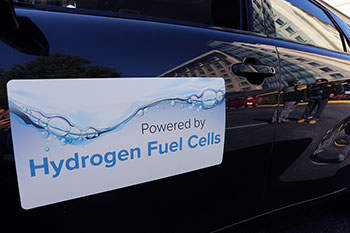 Fuel cells play a major role in creating a clean energy future, with a broad set of applications ranging from powering buildings to electrifying transportation. But, as with all emerging technologies, researchers have faced many barriers in developing affordable, efficient fuel cells and creating a way to cleanly produce the hydrogen that powers them.
Fuel cells play a major role in creating a clean energy future, with a broad set of applications ranging from powering buildings to electrifying transportation. But, as with all emerging technologies, researchers have faced many barriers in developing affordable, efficient fuel cells and creating a way to cleanly produce the hydrogen that powers them.
In a new Perspective article, published in the Journal of The Electrochemical Society, researchers are aiming to tackle a fundamental debate in key reactions behind fuel cells and hydrogen production, which, if solved, could significantly bolster clean energy technologies.
In the open access article, “Perspective—Towards Establishing Apparent Hydrogen Binding Energy as the Descriptor for Hydrogen Oxidation/Evolution Reactions,” Yushan Yan and his coauthors from the University of Delaware provide an authoritative overview of work done in the areas of hydrogen oxidation and evolution, present key questions for debate, and provide paths for future innovation in the field.
Hydrogen oxidation and hydrogen evolution reactions are two of the simplest electrochemical reactions, yet happen to be the backbone to developing critical clean energy technologies.
“These two reactions are the foundation for clean fuel cells,” Yan says. “With hydrogen oxidation, you have a fuel cell reaction. If you do hydrogen evolution, producing hydrogen from water, that’s water electrolysis, which produces clean hydrogen for fuel cells and other applications.”
Currently, fuel cells are primarily known for their role in electrifying transportation. Fuel cell cars have been brought into the marketplace by companies like Toyota, Honda, and Hyundai, who continue to back vehicles powered by clean energy technologies. The majority of modern fuel cells, specifically those used for automotive applications, are proton exchange membrane (PEM) fuel cells, which functions by exchanging protons across an acidic polymer membrane to produce electricity and heat.
However, Yan and his team are looking to improve this model, examining fundamental ways to produce a fuel cell that is more affordable.
“What we want to do is move from an acid to a base,” Yan says. “It may sound very simple, but this change allows us to use nonprecious metals as catalysts instead of the very expensive platinum group metals. We’re really looking to solve the barrier in front of PEM fuel cell technology, making it cheaper and therefore deployable to the mass market.”
The researchers found that as they began the move from an acid to a base fuel cell, both the hydrogen oxidation reactions and hydrogen evolution reactions became much slower, impacting the technology’s efficiency. In the Perspective article, the group outlines this problem and begins to formulate opinions of why this happening, as well as inviting peers in the field to get involved in the conversation.
“Doing research can be competitive, but at the same time, we also need to have more people join the conversation in order for things to start happening faster,” Yan says. “With this article, we’re looking for more people to pay attention to this problem and join us in the debate.”
By taking a closer look at the fundamental reactions that are essential to propelling fuel cell and clean hydrogen production technologies, Yan believes significant strides could be made for future applications.
“When you tackle these very fundamental questions, there could be immediate impact,” Yan says. “In this article, we’re talking about hydrogen oxidation, which is for fuel cells. But we’re also talking about the reverse reaction, which is hydrogen evolution. Hydrogen evolution is about producing hydrogen out of water using wind and solar energy. It’s clean hydrogen. Sure, that hydrogen can support fuel cell vehicles, but hydrogen has many other applications.”
Some of those other applications include ammonia synthesis. Without ammonia-based fertilizers, the world would be unable to grow enough food to feed its population. While ammonia production is critical to humanity, the hydrogen that is needed to produce it comes from fossil fuels. Ammonia is currently made by a reaction between nitrogen and hydrogen, called the Haber-Bosch process, where hydrogen is produced from reforming natural gas. If the hydrogen used in this process was instead produced in a clean method, the overall environmental impact would be extremely improved.
ECS’s Perspective article type provided Yan and his coauthors a unique platform to present their ideas. Instead of a traditional research article, ECS Perspective articles allow researchers to discuss new insights into their field, with the ability to generate new ideas and advance the fields related to electrochemistry and solid state science.
“The Perspective article allowed us to summarize what’s going on in this area, but more importantly, outline what could be done or what needs to be done in the future,” Yan says. “In publishing with the Journal of The Electrochemical Society, I felt we’d reach the most appropriate audience that is well-equipped to come up with new ideas.”
Yan hopes this article can stimulate a conversation around fundamental reactions in fuel cells and begin an exchange of ideas, potentially accelerating advancement in the field.
“My dream scenario,” Yan said, “is that someday, I would see my hydroxide exchange membrane fuel cell get implemented in a car.”


